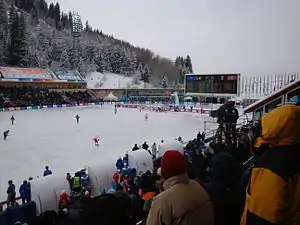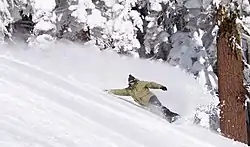Winter sports
Winter sports or winter activities are competitive sports or non-competitive recreational activities which are played on snow or ice.[1] Most are variations of skiing, ice skating and sledding. Traditionally, such games were only played in cold areas during winter, but artificial snow and artificial ice allow more flexibility. Playing areas and fields consist of either snow or ice.
Artificial ice can be used to provide ice rinks for ice skating, ice hockey, para ice hockey, ringette, broomball, bandy, rink bandy, rinkball, and spongee in a milder climate. The sport of speed skating uses a frozen circular track of ice, but in some facilities the track is combined in an enclosed area used for sports requiring an ice rink or the rink itself is used. Alternatively, ice cross downhill uses a track with various levels of elevation and a combination of bends. Long distance skating (a.k.a. "marathon skating") such as tour skating is only performed outdoors and uses the available natural ice from frozen lakes, ponds, and marshes. Tour skating at times includes speed skaters, though tour skates are more common.
Common individual sports include cross-country skiing, alpine skiing, snowboarding, ski jumping, speed skating, figure skating, luge, skeleton, bobsleigh, ski orienteering and snowmobiling.
Common team sports include ice hockey, ringette, broomball (on either an indoor ice rink, or an outdoor ice rink or field of snow), curling, rinkball, and bandy. Based on the number of participants, ice hockey is the world's most popular winter team sport, followed by bandy.[2]
Winter sports at times have their own multi-sport events, such as the Winter Olympic Games and the Winter Universiade.
History

Snow and ice during the winter time has enabled sliding as a means of transportation, using sledges, skis and skates. This also led to different pastimes and sports being developed in the winter season as compared to other times of the year. Naturally, winter sports are more popular in countries with longer winter seasons.

In the European Alps, St. Moritz became a popular winter resort in 1864.[3][4]
In the early days of the Olympics there was not much differentiation between the summer and winter games. These confusions would span from around the late 1890s until the early to mid 1900s. During this time, some sports considered to be winter sports and played or performed during the Olympic Winter Games today, would be held during the Olympic Summer Games. It was originally wanted to keep all of the Olympic sports together under one event and program, but due to environmental demands of some sports, it had to be separated.[5]
While most winter sports are played outside, ice hockey, speed skating and to some extent bandy have moved indoors starting in the mid-20th century. Indoor ice rinks with artificial ice allow ice skating and hockey to be played in hot climates.
Outdoor winter sports will likely be severely impacted because of climate change in the next century.[6][7]
List of winter sports
Note: the Olympic rings next to a sport indicates that this particular sport is included in the Winter Olympic Games, as of the 2014 Winter Olympics in Sochi. The Paralympic logo indicates the same for a sport not in the Olympics but in the Winter Paralympic Games.
Ice skating
Skiing


- Acroski (no longer part of the Winter Olympics)

- Alpine skiing

- Biathlon

- Cross-country skiing

- Downhill skiing
- Freestyle skiing

- Jack Jumping
- Mogul skiing

- Monoskiing
- Newschool skiing
- Nordic combined

- Ski archery
- Skiboarding
- Skibob
- Skijoring
- Ski jumping

- Ski mountaineering

- Ski orienteering
- Snowkiting
- Speed skiing
- Speed riding
- Telemark skiing
- Winter pentathlon
- Ski-BASE Jumping
Sledding

Sports that use sleds going down ice tracks or pulled by something:
Snowboarding
Snowmobiling

- Free style
- Snocross
- Recreation
- Cross-country
- Hill climbing
Team sports

Other sports
- Cold-weather biking
- Barrel jumping - (discipline of speed skating)
- Ice canoeing
- Ice climbing
- Ice cricket
- Ice cross downhill
- Ice racing
- Ice speedway
- Snowbiking
- Tour skating
- Snow drifting[8]
- Snow golf[9] (not to be confused with Crackgar, indigenous Kalash snow golf)
Recreational sports
Some sports are competed in (or simply enjoyed) on a more casual basis, often by children:
- Crackgar (indigenous Kalash snow golf)[10]
- Ice boating or ice sailing
- Ice fishing
- SheenAab Jung[11] (Jammu and Kashmir Snow Fighting)
- Tobogganing
- Snow bowling[12]
Notable winter sporting events
World Cup
- Bandy World Cup
- Biathlon World Cup
- Bobsleigh World Cup
- FIS Alpine Ski World Cup
- FIS Cross-Country World Cup
- FIS Freestyle Skiing World Cup
- FIS Nordic Combined World Cup
- FIS Ski Jumping World Cup
- FIS Snowboard World Cup
- Luge World Cup
- Short Track Speed Skating World Cup
- Skeleton World Cup (toboggan)
- Speed Skating World Cup
- World Cup in Ski Orienteering
World championships
- Ice Hockey World Championships
- Curling World Championships
- Bandy World Championships
- Biathlon World Championships
- Bobsleigh World Championships
- FIS Alpine World Ski Championships
- FIS Freestyle World Ski Championships
- FIS Nordic World Ski Championships (cross-country skiing, ski jumping, and nordic combined)
- FIS Snowboarding World Championships
- FIL World Luge Artificial Track Championships
- FIL World Luge Natural Track Championships
- FIS Ski Flying World Championships
- World Figure Skating Championships
- World Ringette Championships
- World Long Track Speed Skating Championships
- World Short Track Speed Skating Championships
- Skeleton World Championships (toboggan)
- World Ski Orienteering Championships
References
Citations
- "winter sports, noun". Chambers 21st Century Dictionary. Retrieved 22 February 2010.
- "Bandy destined for the Olympic Winter Games!". Archived from the original on 17 October 2018. Retrieved 17 January 2018.
- Potter, Everett (21 November 2019). "St Moritz, The Birthplace Of Winter Sports". Forbes. Retrieved 4 March 2022.
You can make a strong case that the origins of modern winter sports lie here, starting in the 1860's with hotelier Johannes Badrutt, who welcomed a steady stream of well-heeled British guests to his small Kulm Hotel.
- Ben Cocking (2020). Travel Journalism and Travel Media: Identities, Places and Imaginings. Springer Nature. p. 9. ISBN 9781137599087.
The launching of the Cook excursions in Britain (1841), the appearance of the first Baedekker guide (1843), the inauguration of a winter "season" in Saint Moritz (1864), the creation of Yellowstone (1877): these were the important markers of its growth path [mass tourism].
- Martínková, Irena; Parry, Jim (27 November 2020). "Olympic Winter Games, 'Cold Sports', and Inclusive Values". The International Journal of the History of Sport. 37 (13): 1236–1251. doi:10.1080/09523367.2020.1860942. ISSN 0952-3367. S2CID 233215108.
- Bradford, Nick (2019) The Future of Winter Sports and Recreation National Environmental Education Foundation
- Bürki, Rolf (2003) Climate Change and Winter Sports: Environmental and Economic Threats CIPRA.org
- "Cross country for the Winter Olympics". Retrieved 26 July 2016.
- "Snow Golf". Strictly Snow Games. Retrieved 21 January 2017.
- "Snow golf means joys, laughter and feast in Chitral". 6 February 2019.
- "World SheenAab Jung Federation". Archived from the original on 27 July 2021. Retrieved 8 October 2023.
- "Snow Bowling". Strictly Snow Games. Retrieved 21 January 2017.
Sources
- Syers, Edgar; Syers, Madge (eds.) (1908) The Book of Winter Sports London: Edward Arnold OCLC 4531800
- Dier, J. C. (ed.) (1912) The Book of Winter Sports, an attempt to catch the spirit of the keen joys of the winter season The Macmillan Company
- Jessup, Elon Huntington (1923) Snow and ice sports: a winter manual E. P. Dutton & Co.
- Cereghini, Mario (1955) Five Thousand Years of Winter Sports Edizioni del Milione
- Liebers, Arthur (1971) The Complete Book of Winter Sports NY: Coward, McCann & Geoghegan
- "Winter Sports: Sport guides". BBC Online. 20 February 2010. Retrieved 22 February 2010.
External links
 Media related to Winter sports at Wikimedia Commons
Media related to Winter sports at Wikimedia Commons Winter sports travel guide from Wikivoyage
Winter sports travel guide from Wikivoyage


_by_Sandro_Halank%E2%80%930220.jpg.webp)
.jpg.webp)


.JPG.webp)